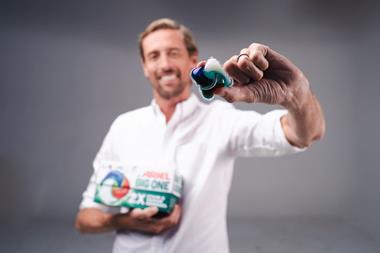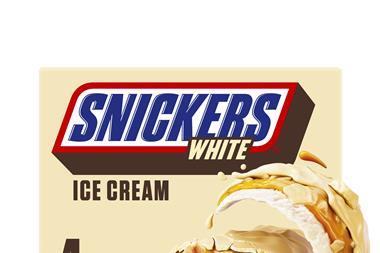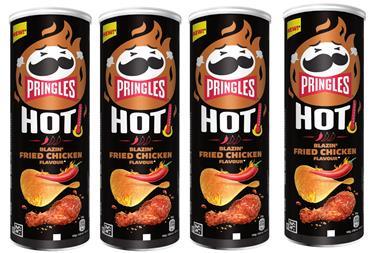Who used the last of the butter? It’s a common enough cry from family breakfast tables all over the UK as the bottom of the tub gets scraped for barely enough yellow stuff to cover a slice of toast. Bad news for the person chosen for the emergency rush to the shop, but a great opportunity for c-stores.
“Butters, spreads and margarines are a valuable category for convenience stores where products are most frequently bought as top-up items or distress purchases,” says Claire Crawford, range and merchandising executive at Unilever. “In fact, it’s a growing market, worth a significant £28.2m to convenience stores and 1.7% in value growth year on year.”
“Most households will have spreads in their fridge and the heavy buyers are large families with older children buying on main shopping trips,” adds Unilever’s Partners for Growth category director Phil Ellis. “In the convenience channel things are different – butters and margarines are a kitchen essential with a high proportion of ‘need it now’ purchases, where consumers have run out.”
According to data prepared by ACNielsen, butters currently make up a 43% value share of convenience pack sales; buttery spreads account for 26%; healthy spreads weigh in at 27%; and the baking category follows at 3%.
Butter back on the table
As these figures show, in the daily battle for the breakfast table – the place where butters, spreads and margarines are used most – butter is making a serious comeback. According to research by Mintel, the market share for spreads is being rapidly eroded by sales of butter, driven by consumers ditching block butter and switching to the growing range of spreadable butters on the market.
“Today’s consumers are looking for taste, health and convenience, and it’s these key drivers that are behind the growth in the spreadables sector, which is the largest by value and the fastest growing within butters and spreads,” says Anchor senior brand manager Emily Oldridge. “We’ve focused our growth on our spreadable products, both standard and lighter.”
Where butters were once banished from the fridge by consumers worried about saturated fat intake, modern consumers are more likely to weigh up health benefits with the demand for taste. Health concerns have inspired lines such as Anchor’s Unsalted block butter, which launched this year, while brands have also developed a marketing message which promotes butter as a natural, single-source food.
“Our research has shown that consumers want convenience without compromising on taste,” says Kerrygold marketing director Sean Whitfield. “That’s why we’ve focused on the fact that we make 100% pure butter and don’t add vegetable oil.”
The trend for cooking from scratch as reflected by TV shows such as Hairy Bakers and Saturday Kitchen has also had a part to play in butter’s recent resurgence. Lurpak’s positioning as ‘the natural way to enjoy food’ combined with recipes available from its website has helped cement its position as market leader.
According to Ian Cameron, trading manager for chill and freeze at Costcutter, consumers’ interest in local produce is also influencing their choices at c-stores. “Regional butters such as Cadog Welsh and Yorkshire Butter work because consumers like to support local brands and feel strongly about food miles,” he says. The organic message is also proving popular at c-store level as premium products like Rachel’s Organic butter make an impact with upmarket consumers.
Meanwhile, as the ‘free-from’ sector expands, goats’ milk products are proving successful with allergy-aware consumers. Delamere Dairy, which relaunched its range this year, has seen sales of goats’ butter up 10% in July 2008 compared with July 2007.
“Growth comes not only from customers who buy other goats’ milk products because they have an allergy or intolerance to cows’ milk, but also from consumers who prefer the taste,” says Delamere Dairy joint managing director Liz Sutton.
Hard times for healthy spreads
As butter continues to be a winner at the c-store checkout, Mintel reports that the sales of healthy spreads have fallen in both volume and value. While consumers’ taste for butter has buoyed sales of buttery spreads such as Utterly Butterly and Clover in the short term, price promotions have depressed sales growth overall. To try to drive category growth this year Dairy Crest launched Clover Lighter, a reduced-fat variant of the buttermilk spread.
“Unilever UK will be supporting the category with marketing activity while communicating the message that Flora contains natural seed oil and is a healthier alternative to butter as it contains less trans fatty acids.”
To boost sales of cholesterol-lowering spreads Flora pro.active has produced ‘infomercials’ starring Gloria Hunniford to reinvigorate the message, while Benecol has opted to reassure consumers that by buying Benecol they’re actively helping their health. Says Benecol marketing manager Esther Van Onslen: “It’s not enough to simply communicate the cholesterol-lowering benefits of the product anymore. We’re now reassuring consumers that they’re doing the right thing by trying to lower their cholesterol.”
Despite what Unilever describes as a “challenging” 2007 there were still selected successes in the healthy spreads sector. Olive-based spreads struck a chord with consumers as Bertolli sales enjoyed 4% growth, while sales of Flora Omega 3 were up 3.6% in the first quarter of 2008.
For c-store owners who are determined to boost sales in the butters and spreads sector, space is the key. Cameron estimates that sales from the chiller should account for 25% of total c-store sales, with butters and spreads making up 10% of that.
“I understand that space is limited in independent outlets, so store managers may choose smaller sizes, but the 500g pack is what people prefer because they see these packs as being better value for money,” says Van Onslen.
Cameron agrees, suggesting that retailers make sure they’re trading up from 250g size to 500g.
On the shopfloor clear merchandising is also an important part of a successful sales strategy. “It really is important that shoppers find what they want quickly and easily,” says Unilever’s Ellis. “If they can’t see the category or the product they have come in for, they will go elsewhere.”
Focus on the future
The future development of butters and spreads is strongly linked to the changing ways that customers consume the first meal of the day.
While brands might be eager to woo cash-rich, time-poor and health-conscious consumers, these are the same people who are likely to skip a traditional breakfast and instead grab other c-store offerings, such as smoothies and cereal bars, on the way to work.
Mintel predicts that although new product development in the sector is extremely low, any innovation is going to come from manufacturers looking at further developing spreadable products, working on new packaging and following the continuing trend for natural products.
“We’re looking at launching some new products for 2009 - the key values for us are purity and naturalness,” says Sean Whitfield from Kerrygold.
“Butters, spreads and margarines are a valuable category for convenience stores where products are most frequently bought as top-up items or distress purchases,” says Claire Crawford, range and merchandising executive at Unilever. “In fact, it’s a growing market, worth a significant £28.2m to convenience stores and 1.7% in value growth year on year.”
“Most households will have spreads in their fridge and the heavy buyers are large families with older children buying on main shopping trips,” adds Unilever’s Partners for Growth category director Phil Ellis. “In the convenience channel things are different – butters and margarines are a kitchen essential with a high proportion of ‘need it now’ purchases, where consumers have run out.”
According to data prepared by ACNielsen, butters currently make up a 43% value share of convenience pack sales; buttery spreads account for 26%; healthy spreads weigh in at 27%; and the baking category follows at 3%.
Butter back on the table
As these figures show, in the daily battle for the breakfast table – the place where butters, spreads and margarines are used most – butter is making a serious comeback. According to research by Mintel, the market share for spreads is being rapidly eroded by sales of butter, driven by consumers ditching block butter and switching to the growing range of spreadable butters on the market.
“Today’s consumers are looking for taste, health and convenience, and it’s these key drivers that are behind the growth in the spreadables sector, which is the largest by value and the fastest growing within butters and spreads,” says Anchor senior brand manager Emily Oldridge. “We’ve focused our growth on our spreadable products, both standard and lighter.”
Where butters were once banished from the fridge by consumers worried about saturated fat intake, modern consumers are more likely to weigh up health benefits with the demand for taste. Health concerns have inspired lines such as Anchor’s Unsalted block butter, which launched this year, while brands have also developed a marketing message which promotes butter as a natural, single-source food.
“Our research has shown that consumers want convenience without compromising on taste,” says Kerrygold marketing director Sean Whitfield. “That’s why we’ve focused on the fact that we make 100% pure butter and don’t add vegetable oil.”
Top five
Top five sellers overall:
1. Lurpak Spreadable slightly salted 250g
2. Utterly Butterly 500g
3. Flora Original 250g
4. I Can’t Believe It’s Not Butter! 500g
5. Flora Original 500g
Source: Unilever’s Partners for Growth
In the butter category this ‘natural’ message is backed up by brands promoting their links with the countryside. County Life has run sampling at UK country shows, while Anchor continued its repositioning as The Free Range Butter Company.
Top five sellers overall:
1. Lurpak Spreadable slightly salted 250g
2. Utterly Butterly 500g
3. Flora Original 250g
4. I Can’t Believe It’s Not Butter! 500g
5. Flora Original 500g
Source: Unilever’s Partners for Growth
The trend for cooking from scratch as reflected by TV shows such as Hairy Bakers and Saturday Kitchen has also had a part to play in butter’s recent resurgence. Lurpak’s positioning as ‘the natural way to enjoy food’ combined with recipes available from its website has helped cement its position as market leader.
According to Ian Cameron, trading manager for chill and freeze at Costcutter, consumers’ interest in local produce is also influencing their choices at c-stores. “Regional butters such as Cadog Welsh and Yorkshire Butter work because consumers like to support local brands and feel strongly about food miles,” he says. The organic message is also proving popular at c-store level as premium products like Rachel’s Organic butter make an impact with upmarket consumers.
Meanwhile, as the ‘free-from’ sector expands, goats’ milk products are proving successful with allergy-aware consumers. Delamere Dairy, which relaunched its range this year, has seen sales of goats’ butter up 10% in July 2008 compared with July 2007.
“Growth comes not only from customers who buy other goats’ milk products because they have an allergy or intolerance to cows’ milk, but also from consumers who prefer the taste,” says Delamere Dairy joint managing director Liz Sutton.
Hard times for healthy spreads
As butter continues to be a winner at the c-store checkout, Mintel reports that the sales of healthy spreads have fallen in both volume and value. While consumers’ taste for butter has buoyed sales of buttery spreads such as Utterly Butterly and Clover in the short term, price promotions have depressed sales growth overall. To try to drive category growth this year Dairy Crest launched Clover Lighter, a reduced-fat variant of the buttermilk spread.
Adding sales
Unilever's Partners for Growth has these top tips on how to maximise c-store sales of butters and spreads
Stock lines from each product group
Make it easy for customers to find the products they want by separating butters, spreads and margarine into the four most popular product groups: butter, buttery spreads, health and baking.
Block vertically by brand
Top sellers should be placed at eye level and products blocked vertically by brand. If space is at a premium retailers can block horizontally.
Allocate the most space to the top selling brands
According to HIM research, 55% of customers who don’t make a purchase say it’s because what they wanted was either out-of-stock or not available. Retailers must ensure they have sufficient stocks and allocate most space to the top selling lines.
Keep chillers tidy
Retailers should check the cabinet regularly to avoid excess frost and dirty marks. A clean, tidy chiller cabinet will reflect positively on the whole store.
Cameron saw sales of I Can’t Believe It’s Not Butter fall at Costcutter amid pricing problems. “A lack of clear promotional strategy resulted in this brand being EDLP in our sector,” he says.
To reinvigorate static sales of spreads, brands have been busy refocusing their products’ health messages. “The battle for 2008 and beyond is to educate consumers about the benefits of spreads,” says Unilever’s Ellis.
Unilever's Partners for Growth has these top tips on how to maximise c-store sales of butters and spreads
Stock lines from each product group
Make it easy for customers to find the products they want by separating butters, spreads and margarine into the four most popular product groups: butter, buttery spreads, health and baking.
Block vertically by brand
Top sellers should be placed at eye level and products blocked vertically by brand. If space is at a premium retailers can block horizontally.
Allocate the most space to the top selling brands
According to HIM research, 55% of customers who don’t make a purchase say it’s because what they wanted was either out-of-stock or not available. Retailers must ensure they have sufficient stocks and allocate most space to the top selling lines.
Keep chillers tidy
Retailers should check the cabinet regularly to avoid excess frost and dirty marks. A clean, tidy chiller cabinet will reflect positively on the whole store.
“Unilever UK will be supporting the category with marketing activity while communicating the message that Flora contains natural seed oil and is a healthier alternative to butter as it contains less trans fatty acids.”
To boost sales of cholesterol-lowering spreads Flora pro.active has produced ‘infomercials’ starring Gloria Hunniford to reinvigorate the message, while Benecol has opted to reassure consumers that by buying Benecol they’re actively helping their health. Says Benecol marketing manager Esther Van Onslen: “It’s not enough to simply communicate the cholesterol-lowering benefits of the product anymore. We’re now reassuring consumers that they’re doing the right thing by trying to lower their cholesterol.”
Despite what Unilever describes as a “challenging” 2007 there were still selected successes in the healthy spreads sector. Olive-based spreads struck a chord with consumers as Bertolli sales enjoyed 4% growth, while sales of Flora Omega 3 were up 3.6% in the first quarter of 2008.
For c-store owners who are determined to boost sales in the butters and spreads sector, space is the key. Cameron estimates that sales from the chiller should account for 25% of total c-store sales, with butters and spreads making up 10% of that.
“I understand that space is limited in independent outlets, so store managers may choose smaller sizes, but the 500g pack is what people prefer because they see these packs as being better value for money,” says Van Onslen.
Cameron agrees, suggesting that retailers make sure they’re trading up from 250g size to 500g.
On the shopfloor clear merchandising is also an important part of a successful sales strategy. “It really is important that shoppers find what they want quickly and easily,” says Unilever’s Ellis. “If they can’t see the category or the product they have come in for, they will go elsewhere.”
Focus on the future
The future development of butters and spreads is strongly linked to the changing ways that customers consume the first meal of the day.
While brands might be eager to woo cash-rich, time-poor and health-conscious consumers, these are the same people who are likely to skip a traditional breakfast and instead grab other c-store offerings, such as smoothies and cereal bars, on the way to work.
Mintel predicts that although new product development in the sector is extremely low, any innovation is going to come from manufacturers looking at further developing spreadable products, working on new packaging and following the continuing trend for natural products.
“We’re looking at launching some new products for 2009 - the key values for us are purity and naturalness,” says Sean Whitfield from Kerrygold.



























No comments yet